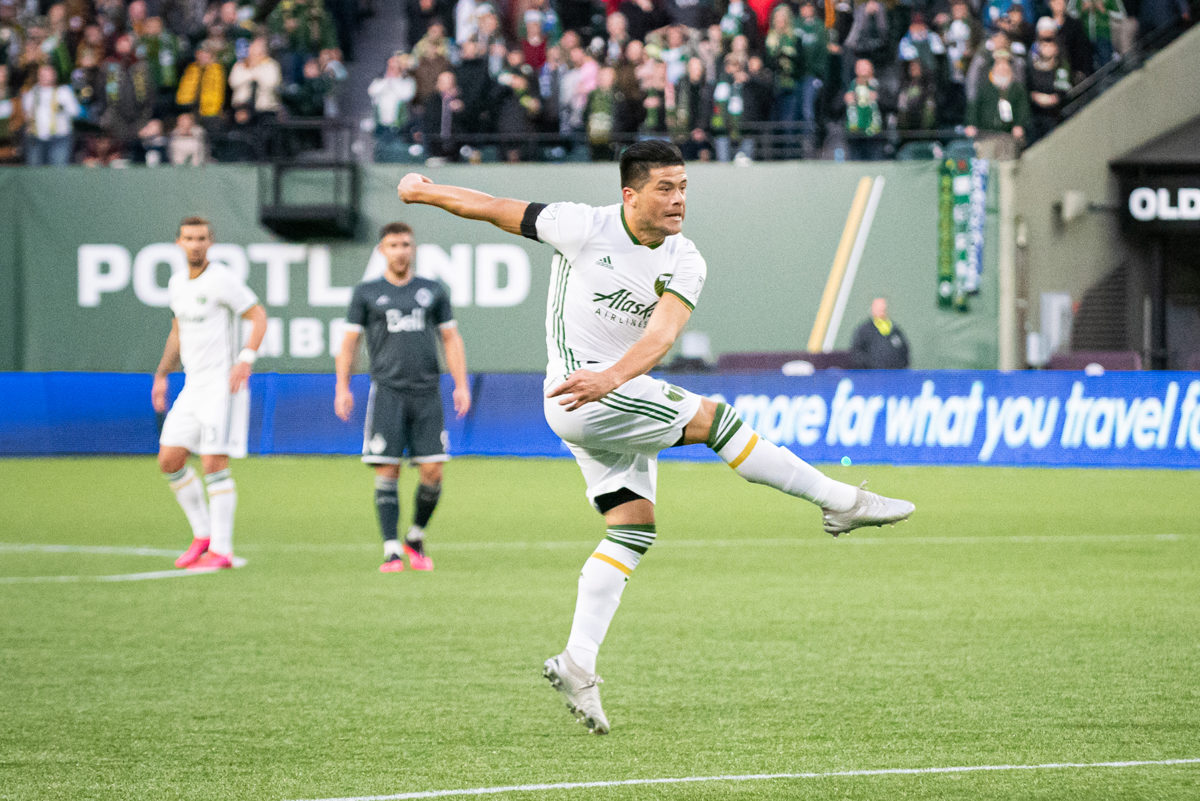An already tough start to the season gets even tougher as the Portland Timbers prepare to deal with the lengthy absence of starting right back, Jorge Moreira.
ESPN’s Taylor Twellman broke the news of a potential long-term injury on Saturday afternoon, and Timbers.com writer, Richard Farley, later shared that the Timbers believe Moreira could have a partial meniscus tear in his left knee that requires surgery.
There have been no reports as to how long a potential surgery would sideline the Paraguayan, and with his loan from River Plate expiring in June, it’s a devastating blow for both the player and the organization.
But injuries happen in sports, and there’s nothing that the Timbers can do other than continue forward. What Moreira brings to the team is difficult to replace, but adjustments will have to be made. However, before looking at how the Timbers can move forward, it’s important to understand what Moreira brought to the team.
What the Timbers will be missing
Anytime an MLS side signs an experienced player from South America, especially from teams such as Boca Juniors or River Plate, they expect a talented player that can come in and contribute right away. A season ago, the Timbers needed a starting-caliber right back, and they found their guy in Moreira—a player with 57 starts for River Plate under his belt.
The 30-year old plays a huge role in the Timbers’ attack, often tasked with making overlapping runs into the final third, sending in crosses for strikers in the box, and, if necessary, using his speed to track back and win the ball back in defense.
When Portland plays out of the back, Moreira’s job is straightforward: find a way to beat the first line of defense. In the clip above, Moreira does a good job of beating Minnesota United’s initial pressure before finding Sebastian Blanco with plenty of room to exploit down the left wing. By beating that first line of defense, the Timbers create advantages in midfield that they hope to exploit.

Sometimes, defenses can’t stop him, and when this happens Moreira is more than happy to blaze by and immediately burst into the final third. In the clip above, Moreira continues to run into the vacated space before whipping a cross into the box. While the play didn’t result in a goal, Moreira’s aggression is on full display as he creates another dangerous opportunity for his team.
However, Moreira can be most advantageous in the final third when the Timbers need to provide service to runners in the box.
Oftentimes, Moreira will play a one-two with a midfielder as he makes an overlapping run before swinging a cross into the box. Above are two different examples of the crosses that he makes. Against New York Red Bulls, Moreira’s cross is low, finding the feet of Cristhian Paredes near the penalty spot. In the game against Vancouver, Moreira sends a lofted cross into Jeremy Ebobisse at the perfect height for an attempted header.
Just Moreira’s presence in Portland’s attacking third adds another layer to the Timbers offense. When plays break down, he serves as an extra player in and around the area, another body that can capitalize on a stray bounce or get on the end of a cross.
In the goal above, Moreira pulls out a moment of individual brilliance as he quickly thinks to chip a rebound over the head of Chicago’s keeper.
In Columbus, his late run to the back post provided Paredes with a passing option. Moreira took advantage by helping the Timbers secure their first win of the 2019 season.
If there are any areas of his game that gave Timbers’ supporters headaches, it is in Moreira’s aggression to get forward whenever possible. While he can hold his own defensively, Moreira is often caught too high up the pitch, leaving acres of space for opposing attackers to run into. In the season opener against Minnesota United, all three of the Loons’ goals came from a counter-attack that involved players streaking down the vacated space in the flanks.
Being caught upfield on the wings is a common problem that can be fixed through adjusting playing style or tactics. What Moreira brings to the game, and the spacing that he provides, is valuable and will be missed—he is a TAM player after all.
Ultimately, all of this begs one simple question: How will the Timbers adjust to life without Moreira for a prolonged amount of time?
How can the Timbers adjust?
If there’s one area where Timbers couldn’t afford to lose players to injury, it’s the defense. With the loss of Zarek Valentin and a majority of Portland’s depth concentrated at center back, head coach Giovanni Savarese will have to get creative when it comes to the outside back position.
The Timbers have employed a four-man backline throughout a majority of its MLS history, but maybe it’s time that Savarese has to think about converting to a back three to fit the personnel.
The utilization of a back three has been gaining traction within the league—and in international soccer—over the past few years. This setup has a number of benefits which include the ability to create a numbers advantage in the midfield, make life difficult for teams lining up with a single striker, and being more defensively sound at the back.
Atlanta United made the switch to a back three under former head coach Tata Martino and rode it to large amounts of success, including an MLS Cup. In Martino’s system, Julian Gressel, Atlanta’s right back, was free to roam up and down the entire right side, picking out crosses and helping the team in transition moments.
Another proponent of a back three is Manchester City, where, under the leadership of Pep Guardiola, they won the Premier League. City don’t have an outside back like Gressel, but the ability to re-allocate their numbers to provide advantages elsewhere on the field proved to be very beneficial.
In the Timbers’ system, a back three would most likely consist of Dario Zuparic, Larrys Mabiala, and Chris Duvall. The question in that situation would be how Portland wants to play in midfield. Do they experiment with Andy Polo in that position, something that they did in the preseason? On the opposite side, does a shift in formation force Jorge Villafaña to the bench? Would all of this force Yimmi Chará to play a Gressel-eque role on the right side?
A side benefit of playing a 3-5-2 or 3-4-3? Unleashing Diego Chará as an ultimate force in the midfield by allowing him to focus solely on doing what he does best: destroying plays. With two center backs, Chará is often tasked with dropping into the backline, either to help defend or to start possession from the back. With a third center back, Chará wouldn’t have to worry as much about screening the backline or dropping back to receive the ball; he would be free to roam around the defensive midfield and put out fires.
However, it’s significantly more likely that Savarese sticks with the tried and true four-man backline. Twenty-one-year old Marco Farfan has MLS experience at right back and could slide right in to replace Moreira. This would allow Villafaña to stay in on the left and requires the least amount of change tactically. The only thing that could be an issue is how Portland deals with the ever-increasing talent of MLS wingers. In the next few weeks, the Timbers will come up against David Accam, Gustavo Bou, the duo of Carlos Vela and Diego Rossi (!!!), Ilsinho, and Alberth Elis. A 30-year old and 21-year old having to deal with that quality could very well put the Timbers in dangerous predicaments on defense.
Another question that needs to to be asked: regardless of tactical formation, does Savarese still push both outside backs high? Or does he play more conservative, with one, or both, players sitting in the defensive half?
Pushing both outside backs high limits dangerous wingers by forcing them to defend, but throughout the preseason and one game of the regular season, Portland has been continuously exploited down the flanks. Without a purely attack-minded defender for the distant future, Savarese could decide to take this more conservative approach on the wings. Time will tell.
This injury to Moreira, arguably one of Portland’s most important defenders, couldn’t have happened at a worse time. With Savarese still searching for defensive solutions after last week’s 3-1 defeat—and a two-game road trip coming up—the Timbers will have to come up with a fix quickly.
Hindsight is 20/20, and after playing a few games, the Timbers may be wishing that they had a little more depth in defense.

